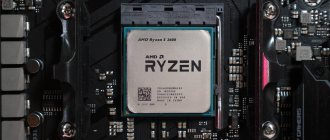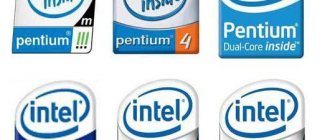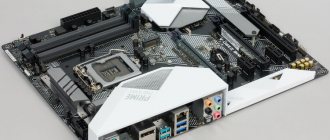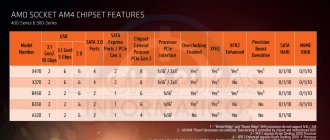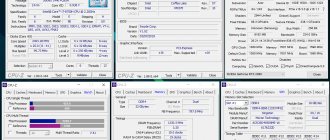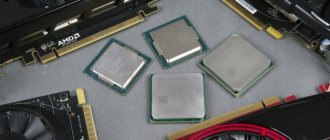basic information
This processor went on sale in the Russian Federation on April 11, 2020, that is, the model is considered relatively new.
Prices for this device start at 14,700 rubles, and average about 16,500 rubles.
At the same time, the device can easily compete in performance and reliability with Intel Core devices that were released around the same period, but cost almost 6,000 rubles more.
But low price is not the only advantage of this model, due to which it can successfully compete in the market. In some respects it is superior to modern Intel developments, and certainly not inferior to them. And thanks to their lower price, such processors have now already taken a stable position in the market in their middle price segment.
If previously AMD had never positioned itself as a manufacturer of a mass product, then starting with this processor, everything has changed.
It is positioned as an average device aimed at the average consumer. Whereas earlier models were high-speed and their prices started from $350.
However, the transition to the mass market does not at all mean a decrease in the quality of devices.
Processors in the mass segment do not have premium speed characteristics - they are emphasized differently.
The goal was to maintain sufficiently high performance and stability while reducing the price of the device.
<Fig. 1 Processor>
Architecture
What is the fundamental difference between such devices and similar ones?
First of all, these processors are created on the basis of a fundamentally new microarchitecture, which has not previously been found either in models of this brand or from other manufacturers. This is the Zen microarchitecture.
This architecture aroused great interest among specialists, and although its presentation took place a month and a half before it went on sale, the debate about it lasted almost six months.
But these debates did not always proceed in a positive manner.
For example, during testing and studying specific technical characteristics, experts discovered that although the device shows good results in tests for working with digital content, it is of little use in gaming systems.
Important! This atypical focus on performance may seem like a bad decision. However, if you select a processor for specific purposes, it will perform well.
Processors from this brand have always focused on multi-cores, which is not always the best solution.
That is, with similar characteristics, a device from Intel always has a smaller number of cores.
But in the case of the new architecture, multi-core is a good solution, since the distribution of performance per core is quite high.
<Fig. 2 Appearance>
The lineup
The Ryzen 5 line released several devices that differed from each other in characteristics and features.
And although all the models in the line turned out to be quite successful, it is the 1600x model that has the best characteristics.
The reasons why this model has become the flagship of the series are given in the table below.
Table 1. Technical characteristics of the 1600x modelIndicator Value
| Number of cores | 6 |
| Number of threads | 12 |
| Base operating frequency | 3.6 GHz |
| Frequency of operation in turbo mode | 4.0 GHz |
| Processor die configuration | 3+3 |
| Supported memory type | DDR4-2666 |
| L3 cache volume, megabytes | 16 |
The official price of this device compared to other models in the line is quite high and amounts to almost $250.
<Fig. 3 CPU cover>
Crystal
The processor runs on a Zeppelin semiconductor chip, like many previous models from this manufacturer.
Its structure consists of two blocks of four cores, that is, despite the fact that the processor is six-core, it is based on an eight-core system.
Moreover, this also applies to quad-core processors of this line.
How do manufacturers achieve such a system and why is it needed at all? “Extra” cores in this case are blocked at the stage of production of the crystal and processor.
This “complexity” is necessary for the manufacturer because it helps to sell defective crystals for which one or another part does not work, with great benefit both for themselves and for the end consumer, since this reduces the final cost of the device.
Moreover, it is quite interesting that the circuits for turning off the cores in the chip differ for different models in this line. The 1600x model discussed in this material has one core disabled in each crystal block, while the 1500 model has two cores disabled in each block, and the 1400 has one of the blocks completely disabled (by the way, because of this, the latest model has half the size of the L3 cache).
This shutdown scheme leads to the fact that for the “older” models of this line, including the 1600x under consideration, the high frequency of memory operation remains very important, since the bus inside the processor is synchronized with it.
The same bus that connects two blocks of cores.
If the frequency is not enough, then the connection between the blocks will be unstable, which will lead to a decrease in the stability of the entire processor, and therefore the computer.
<Fig. 4 Packing>
Processor device
Judging by the price category of the device, the manufacturer directly opposes it to the Intel Core i5 device, and at the same time, has every chance of winning in this confrontation due to its lower price.
Intel processors traditionally have higher frequencies, but fewer cores.
Although the nominal frequency of the 1600x is stated as 3.6 GHz , in real conditions and with a real load it is about 3.7 GHz, and with a load of only 1-2 cores - 4 GHz.
The processor has a port for connecting Socket AM4. It works properly in any motherboards that have the appropriate socket. Compatible logic sets - X370, B350 and others like that.
But, despite this, there are very specific recommendations from the manufacturer. AMD recommends using the B350 chipset primarily with this processor.
Although it has a slightly simpler design than the Ch370, it is a more appropriate choice when using such a processor.
Among the disadvantages of this chipset is its lack of support for multiple GPUs simultaneously. However, it is quite capable of overclocking such a device.
In addition, this chipset is good because it is low in cost, which, combined with the reduced price of the processor, allows you to save significantly when assembling a personal computer.
<Fig. 5 Price dynamics>
Cooling system
The thermal package of this device is 95 W. In reality, the device does not heat up at all much compared to other devices in this price segment.
The built-in cooler and standard cooling system allows you to maintain the operating temperature within 58 degrees.
An interesting feature of the processors of this brand is that when checked using the processor’s own thermal sensor, the indicators turn out to be overestimated by 20 degrees .
Manufacturers claim that this was done to ensure that cooling systems work more aggressively with this device, since they focus specifically on the performance of the processor’s own thermal sensor.
Some processor diagnostic utilities can additionally show real parameters, but when using others, it is necessary to make allowances for this feature.
The maximum permissible true heating of the device (without correction for the characteristics of the temperature sensor) is 100 degrees.
Important! When purchasing, please note that although all other processors of this brand were equipped with a cooling system, devices in this line do not have such systems. Such features are most likely due to the fact that the manufacturer did not want to add expensive complex systems that would raise the final price of the device. But a simple cheap cooler would not have been enough here.
<Fig. 6 Model range>
AMD Ryzen 5 1600X processor: the return of the “people's six-core processors”
The return of the “people's six-core processors” Methodology for testing computer systems of the 2020 model
Simultaneously with the announcement of the top-end desktop processors of the Ryzen 7 family, AMD revealed basic information about the more “popular” models of the Ryzen 5 line, mentioning, however, that these processors themselves will go on sale only in the second quarter of this year. Later, the date of their actual publication was also established: contrary to the forecasts of pessimists, it was the very beginning of the quarter, and not its end. At the same time, as expected, the processors are positioned as competitors to the Core i5 in terms of prices, but even the younger 1400 and 1500X are capable of performing eight threads of calculations simultaneously - similar to the desktop Core i7 for LGA115x. Moreover, even the older six-core Ryzen 5 1600X has a recommended retail price at the level of not only the older, but also the only “overclockable” one in the Core i5-7600K line, but in the Ryzen family the multipliers are unlocked without exception. On the one hand, this, of course, “beats” the 1600X and 1500X - after all, you can “play around” with their cheaper “brothers” with indexes 1400 and 1600 (and this is more useful: the maximum achievable frequency will be approximately the same). On the other hand, all models in the family are relatively inexpensive, so if overclocking is not of interest to you, then the new processors are also suitable. Yes, of course, a direct comparison with the Core i5 in terms of prices is not entirely correct, since it is not necessary to purchase a discrete graphics card for Intel processors. But it is gamers and other enthusiasts who have suffered the most due to the lack of “big leaps” in increasing the performance (or, at worst, the number of cores) of mass-produced processors, and for them the issue of buying a discrete video card is not an issue.
In general, the phased introduction of the new AMD platform to the market continues in strict accordance with the company's plans. First, it was necessary to demonstrate the ability to produce high-performance processors, which some users already began to doubt - and doubts were removed. Now it’s the turn of cheaper processors, and over time, mass-produced APUs will also appear on sale. However, it is easy to notice that the cheaper
does not mean
slow
: despite positioning at the Core i5 level, for the same money AMD is ready to ship 8-12 computation threads, i.e., what Intel’s product range corresponds to Core i7, and not necessarily for a mass platform. Actually, some users, as we already wrote, expected six cores for LGA115x back in 2020 - and now it’s already 2017, and... they’ll have to wait some more.
Or they will have to take a closer look at AM4 - AMD supplies what they are looking for, and even cheaper than quad-core Core i7s. At first glance, this is a very generous offer. And we will check what to expect from it in practice during our testing. True, at the moment we have only managed to get acquainted with the Ryzen 5 1600X - the most expensive processor in the line. In absolute terms, it is, of course, inexpensive, but still “jumps out” beyond the psychologically important mark of $200, and there it is already not far from the Ryzen 7 1700. It is clear that the latter will be slower in single-threaded applications (of which, to date, a little more than most), but as many as eight cores look more attractive than six. And if the goal is to save money, the younger Ryzen models “without X” cope well with it, fortunately they are also overclockable (and an expensive board is not required for this: AMD does not limit overclocking only to the top chipset). In short, the question of choosing a specific Ryzen model is not so simple and depends on a lot of factors - with Intel in this regard, everything is clearer (but also much more boring). Having tested only the older Ryzen 5 1600X and Ryzen 7 1800X, it is impossible to answer this question, and we do not yet have other processors of the new family. So let’s try to solve a simpler problem: we’ll simply evaluate the scalability of the architecture in this pair, later expanding the “area of knowledge” with the results of other AMD Ryzen processors.
Test bench configuration
As mentioned above, so far only one representative of the middle family has fallen into our hands, and the eldest in it. In principle, the process of putting into operation a new testing methodology is already underway, but it is not completed, and we considered it irrational to speed it up in this case - after all, there is no large base for comparison yet. Therefore, we will postpone the transition to the new method a little longer - other processors for AM4 and not only should appear. And today’s testing will, to some extent, be an addition to the study of the AMD Ryzen 7 1800X.
| CPU | AMD Ryzen 5 1600X | AMD Ryzen 7 1800X |
| Kernel name | Ryzen | Ryzen |
| Production technology | 14 nm | 14 nm |
| Core frequency, GHz | 3,6/4,0 | 3,6/4,0 |
| Number of cores/threads | 6/12 | 8/16 |
| L1 cache (total), I/D, KB | 384/192 | 512/256 |
| L2 cache, KB | 6×512 | 8×512 |
| L3 cache, MiB | 16 | 16 |
| RAM | 2×DDR4-2400 | 2×DDR4-2400 |
| TDP, W | 95 | 95 |
| Price | N/A | T-1720383938 |
Based on the characteristics, it is easy to notice that the Ryzen 7 1800X and Ryzen 5 1600X differ, in fact, only in the number of active cores: they are based on the same crystal, including two CCX - just one core in each is disabled in the 1600X. Accordingly, a direct comparison of these processors with each other simply suggests itself. Moreover, this is the maximum frequency that AMD is ready to guarantee. And practically this is also the maximum: attempts to reach 4 GHz on all cores become successful only when the supply voltage is increased (with all that it implies), and this is true for both 1800X and 1600X. For their cheaper “brothers” this is also true, which is why we wrote above that for an overclocker they are of the greatest interest (unlike Intel processors, where only older models in the lines or representatives of the initially “crashing” range are “allowed” to overclock mainstream HEDT platforms). “X” in this situation is precisely the maximum that is guaranteed to be achievable while maintaining all the manufacturer’s obligations. But the maximum is different (due to the difference in the number of cores), and for different money - after all, the recommended retail prices of these processors differ by about two times. Their performance, even ideally, should differ to a lesser extent, but for a more accurate answer to the question “by how much?” needs to be tested. And preferably - in the closest possible conditions, which is what the manufacturer practically provided. In this case, we only had the choice of RAM frequency, but since the Ryzen 7 1800X was last tested with DDR4-2666, there was nothing to choose from 
| CPU | Intel Core i7-3770 | Intel Core i7-6700K | Intel Core i7-7700K | AMD FX-8370 |
| Kernel name | Ivy Bridge | Skylake | Kaby Lake | Vishera |
| Production technology | 22 nm | 14 nm | 14 nm | 32 nm |
| Core frequency, GHz | 3,4/3,9 | 4,0/4,2 | 4,2/4,5 | 4,0/4,3 |
| Number of cores/threads | 4/8 | 4/8 | 4/8 | 4/8 |
| L1 cache (total), I/D, KB | 128/128 | 128/128 | 128/128 | 256/128 |
| L2 cache, KB | 4×256 | 4×256 | 4×256 | 4×2048 |
| L3 cache, MiB | 8 | 8 | 8 | 8 |
| RAM | 2×DDR3-1600 | 2×DDR3-1600 / 2×DDR4-2133 | 2×DDR3-1600 / 2×DDR4-2400 | 2×DDR3-1866 |
| TDP, W | 77 | 91 | 91 | 125 |
| Price | T-7959318 | T-12794508 | T-1716356308 | T-11149970 |
The remaining guidelines are taken from earlier tests. Once again, we shook off the dust from the AMD FX-8370 and Core i7-6700K, and also, at the “requests of the workers,” we added the Core i7-7700K, which we were not going to test using this method, but the process itself is not difficult when using a discrete video card presents We don’t need models for LGA2011-3 today: although the 1600X is somewhat similar to some of them in terms of formal features (six cores), it “lives” in a completely different price range. But the old Core i7-3770 for LGA1155 will be useful to us: since questions were raised by the statement that older models for AM4 may be of interest specifically to users of this platform who are thinking about upgrading the system, we decided to clearly illustrate it.
Once again, we shook off the dust from the AMD FX-8370 and Core i7-6700K, and also, at the “requests of the workers,” we added the Core i7-7700K, which we were not going to test using this method, but the process itself is not difficult when using a discrete video card presents We don’t need models for LGA2011-3 today: although the 1600X is somewhat similar to some of them in terms of formal features (six cores), it “lives” in a completely different price range. But the old Core i7-3770 for LGA1155 will be useful to us: since questions were raised by the statement that older models for AM4 may be of interest specifically to users of this platform who are thinking about upgrading the system, we decided to clearly illustrate it.
Testing methodology
As mentioned above, for the first express testing we used “last year’s” test methodology, which is described in detail in a separate article. Let us briefly recall here that it is based on the following four pillars:
- Methodology for measuring iXBT.com performance based on real applications of the 2020 sample
- Methodology for measuring power consumption when testing processors
- Methodology for monitoring power, temperature and processor load during testing
- Methodology for measuring performance in games iXBT.com sample 2016
And detailed results of all tests are available in the form of a complete table with results (in Microsoft Excel 97-2003 format). In our articles, we use already processed data. This especially applies to application tests, where everything is normalized relative to the reference system (like last year, a laptop based on a Core i5-3317U with 4 GB of memory and a 128 GB SSD) and grouped by areas of application of the computer.
This time we did not use gaming tests at all: as was shown last time, the Ryzen family processors themselves do not have any performance problems in this class of applications, and we will study the intricacies of their operation a little later: in more recent » games and on a more powerful video card.
iXBT Application Benchmark 2016
The difference between the i7-6700K and i7-7700K is larger than expected when comparing clock speeds, but we'll get to that later. At the moment, what is more interesting is that the 1600X/1800X pair behaves worse than one might expect based on the number of cores. This is due to the peculiarities of the software. To the greatest extent is After Effects, which copes with the test task faster on six than on eight cores. What is typical is that “this is not a bug - this is a feature”: the effect also appears when comparing Intel processors for LGA2011-3, and it looks exactly the same in relative terms with higher absolute performance. Accordingly, we come to the conclusion: even if all programs “know how” to use a large number of processor cores, this is still not enough - they need to use them in the “correct” way. And it is advisable to compare identical nuclei - quantity does not always translate into quality. As we can see, this is currently typical not only for Intel products - having returned to the high-performance segment, AMD began to experience the same problems. But this, of course, is a problem only for the older and most expensive models - playing into the hands of Ryzen 5, taking into account their prices. Six-core models of this family perform at the level of modern Core i7 (even if expressed cautiously), but cost as much as Core i5. Accordingly, for users of “outdated” Core who are thinking about upgrading, as mentioned, they may be interesting. It’s easier and cheaper to install a used i7-3770 into an existing system than changing the platform, but sometimes you have to change it (at least because of the failure of motherboards, and not only), and in this case, of course, everyone The buyer wants to get the maximum return at the minimum cost.
When processing photographs, the difference between 1600X and 1800X is even smaller, which is expected: programs in this group are less sensitive to the number of computing cores. Taking into account the prices, there is one more argument in favor of Ryzen 5. Despite the fact that this family in this case loses to the Core i7, it can do it, fortunately it costs less. In any case, it beats the old Core i7 quite convincingly.
In contrast, this case is radically single-threaded and without the use of modern command extensions. In principle, as one would expect, the efficiency of Ryzen processor cores (regardless of the numbers) is the same - at similar frequencies the performance is the same. Interestingly, the Core i7-3770 operating at a comparable clock frequency demonstrates the same performance - models running LGA1151 are not least ahead due to their frequencies. In general, Ryzen ~ Ivy Bridge as a first approximation. But in top modifications - with a large number of cores, and for less money (considering, of course, the positioning “during life”: sales and the secondary market can behave as they please).
As we remember, among processors for LGA2011-3, the maximum performance in this program is demonstrated by six-core models, and they are also slower than the same Core i7-3770. Among Ryzen, the six-core 1600X also turned out to be the fastest, only both currently tested processors of this architecture are faster than the same Core i7-3770. However, we will not be surprised if the Ryzen 5 1500X turns out to be even faster - this is just another fact in the treasury of the importance of not just “multithreaded optimization”, but “correct multithreaded optimization”. And the influence of qualitative, and not just quantitative characteristics on the final performance, of course.
Although sometimes quantity is enough. And don’t blame the Ryzen 5 1600X for the fact that it lags behind the Core i7-7700K - if AMD had claimed absolute leadership everywhere, the prices would have been different. Taking into account the current ones, it can sometimes afford to lag behind (especially, as we will see later, not everything is going smoothly with the operation of the system on the 7700K).
As has been said more than once, Skylake processors do not cope with archiving very convincingly compared to their predecessors. The current Ryzens are also not ideal, but in practice they are quite fast. If we remove unpacking (which is still performed in one thread), it will be even better in relative terms.
And file operations with the same drive can be ignored: to a small extent they depend only on single-threaded performance, which is why the 1600X, 1800X and 3770 (recall that above we “agreed to consider” its cores to be approximately the same as Ryzen) are close with an accuracy of almost measurement errors.
The requirements of this program for the system are very diverse: as has been said more than once, it is very sensitive to the number of “physical” cores, has a cool attitude towards “virtual multithreading” technologies, but does not disdain fast memory and capacious caches. Actually, the latter, it seems to us, to a large extent hinders the current Ryzen (both tested in any case) - the third level cache memory is actually divided between CCX (i.e., access to “foreign” is carried out slower than to “our own” for kernels), which makes data exchange difficult. However, the top-end Ryzen 7 1800X demonstrated results at the level of modern Core i7 for LGA1150/1151. The Ryzen 5 1600X is slower in proportion to the number of cores - and this is, rather, somewhere around the modern Core i5, and not the fastest. But they are also faster than the “old” Core i7. And much faster than the best AMD processors sold just last year, which have already had to be compared almost with Pentium. At least in similar applications.
If all applications loaded all cores evenly, given the approximately equal frequencies of the Ryzen 7 1800X and Ryzen 5 1600X, one would expect a 25-30 percent advantage for the first. In fact, which is no secret, the performance of increasing the number of cores grows non-linearly, and sometimes does not grow at all (if two are enough, for example) or turns out to be lower than expected (due to the characteristics of specific programs and migration of processes by default). All this, of course, primarily “harms” multi-core processors: a couple of cores are always disposed of correctly, four - not always, and six or eight - sometimes. On the other hand, if you don’t have to pay too much for them, and tasks where the number of cores matters, at least sometimes have to be solved, why not? Especially if you only need to pay for the processor, which is what AMD is now offering to play - as we already wrote, even the Ryzen 7 1800X, together with the motherboard, can compete in price with junior six-core processors for LGA2011-3, although it is comparable in performance to eight-core, and the Ryzen 5 1600X is significantly cheaper... But it is very similar to the six-core Core i7-5820K/6800K in terms of average performance. That is, the cores, in general, are quite “honest” and comparable. Which is an additional argument in favor of the chosen strategy of gradually introducing models to the market from older to younger ones - it’s not very often that these “oldest” ones noticeably win. The very junior ones (not counting Ryzen 3 and APU), however, were somewhat limited by the company in terms of frequencies, but with an unlocked multiplier, we would not be surprised if it turns out that “the locks are designed against honest people.” In any case, for a budget-conscious buyer (unless, of course, he doesn’t mind a discrete video card), AMD’s approach turns out to be more flexible and convenient: multi-core processors are at least as good as “low-core” processors, and are also designed for the same inexpensive platform.
In fact, which is no secret, the performance of increasing the number of cores grows non-linearly, and sometimes does not grow at all (if two are enough, for example) or turns out to be lower than expected (due to the characteristics of specific programs and migration of processes by default). All this, of course, primarily “harms” multi-core processors: a couple of cores are always disposed of correctly, four - not always, and six or eight - sometimes. On the other hand, if you don’t have to pay too much for them, and tasks where the number of cores matters, at least sometimes have to be solved, why not? Especially if you only need to pay for the processor, which is what AMD is now offering to play - as we already wrote, even the Ryzen 7 1800X, together with the motherboard, can compete in price with junior six-core processors for LGA2011-3, although it is comparable in performance to eight-core, and the Ryzen 5 1600X is significantly cheaper... But it is very similar to the six-core Core i7-5820K/6800K in terms of average performance. That is, the cores, in general, are quite “honest” and comparable. Which is an additional argument in favor of the chosen strategy of gradually introducing models to the market from older to younger ones - it’s not very often that these “oldest” ones noticeably win. The very junior ones (not counting Ryzen 3 and APU), however, were somewhat limited by the company in terms of frequencies, but with an unlocked multiplier, we would not be surprised if it turns out that “the locks are designed against honest people.” In any case, for a budget-conscious buyer (unless, of course, he doesn’t mind a discrete video card), AMD’s approach turns out to be more flexible and convenient: multi-core processors are at least as good as “low-core” processors, and are also designed for the same inexpensive platform.
But taking into account the limitations of the software, you have to focus not only on comparison by the number of cores - intensive methods, such as increasing single-threaded performance, are more effective than extensive ones, since they affect everywhere and everywhere, and not just by luck. And here, it would seem, the complaints that last time we compared the Ryzen 7 1800X with the Core i7-6700K, but not with the i7-7700K, become fair: as we see, the latter actually works noticeably faster, and, it would seem, all else being equal. Well, the time has come to move on to these very “other equals”.
Energy consumption and energy efficiency
In principle, the first alarm bells sounded during the first testing of Kaby Lake on our website, when the integrated performance of the Core i7-7700K turned out to be 2.5% higher compared to the Core i7-6700K, but with a 17% increase in power consumption. At the same time, both processors were tested on the same board based on the Z270 chipset (earlier results of the i7-6700K on a board with the Z170 were 4% lower, which, as we see, exceeds the difference between the processors) and with the same DDR4-2133, and using an integrated GPU. We did not re-test the i7-6700K, taking the results obtained at one time on a simpler B250-based board, but we tested the i7-7700K with the DDR4-2400 specification. And also on the Z270, although in the Gigabyte implementation, not Asus. As a result, we got the “super-linear” performance increase shown above... But compared to the increase in energy consumption, it simply fades.
In principle, this is something that was discussed several times before the start of energy consumption measurements: different instances of processors can behave differently, and even react differently to environmental conditions. On the other hand, everything may not be so scary if you remember the previous “Refresh”: on the same board, the i7-4770K turned out to be significantly more economical than the i7-4790K, and the latter was not completely “terrible” - it was just a return to the level of the i7-3770, but with higher performance than both the latter and the i7-4770K. Now the same thing has happened again, and it has been aggravated due to the use of faster memory and, accordingly, a greater load on the ICP and cache. That is, increasing the Core i5/i7 is in principle possible, but it is not the “evil will” of Intel that holds it back, but a simple reluctance to increase power consumption, which with extensive methods (hello overclockers!) grows much faster than performance. Although, of course, there is a reserve - it’s not for nothing that the mounting system for coolers on the mainstream Intel platform has remained identical since 2009: therefore, the upper limit is the first generation Core for LGA1156, which in the competition for the position of “heaters” can compete even with solutions for AM3+. But sometimes you have to return to the roots to some extent - as when updating LGA1151, when Intel decided to slightly improve the new solutions. And since there is still not one manufacturer on the desktop processor market, but at least two, the “mismatch” of their actions may look like this. If the Ryzen 7 1800X consumes slightly more power than the Core i7-7700K, then the Ryzen 5 1600X is more economical than the latter.
However, this does not apply to the minimum (= single-threaded) load mode - in it (yet?!) the behavior of solutions for AM4 leaves much to be desired, at least from the point of view of a perfectionist. As a result, the “energy efficiency” of the Ryzen 5 1600X is slightly higher than that of the Ryzen 7 1800X (due to the fact that the maximum consumption values at full load on all cores are lower), but it is not so much inferior to the older representative of the “seventh generation” Core . In any case, it is superior to solutions for LGA1155 to a much greater extent, and it can compete on equal terms with the fastest processors for LGA1150 and the newest models for LGA2011-3 (i.e. Broadwell-E). This is not surprising: we repeat that when trying to squeeze out maximum performance, it grows more slowly than power consumption. Processors for LGA115x are, in fact, thoroughly overclocked mobile models. The scalability of modern generations of Core is, of course, good, but there is a limit to everything. And if AMD has to work “to the limit” anywhere, it is in the Ryzen 7 1800X, but not in the “simplified” Ryzen 5 1600X - a flexible approach to the number of cores allows you to expand the range of processors for AM4 in this direction. Intel does not have such freedom of maneuver, for which the company itself is to blame. However, until recently this state of affairs did not bother her, but now, perhaps, she will have to think about it.
Total
Potentially, the Ryzen 5 1600X could be about a quarter slower than the Ryzen 7 1800X, which directly follows from the performance characteristics of the processors: they differ only in the number of active cores. In reality, not all programs are capable of using even 12 computation threads, let alone 16 - accordingly, in general, the difference between these models can be reduced to zero. But the recommended retail prices of these processors differ by approximately half, which is even theoretically achievable from the point of view of fans of spherical price-performance ratios. Outside the spherical vacuum, it has long become commonplace that the further you are from the mass segment, the more expensive the productivity is, and the matter is not always limited only by money (but it is always required). But the Ryzen 5 family practically falls into the mass segment, which makes it extremely attractive to buyers: below that it is unlikely that you will be able to save significantly. Plus, AMD’s approach to developing new processors at the moment looks interesting, which, in particular, allows them to offer even six-core processors relatively inexpensively. Which, we note, do not require any special motherboards, and in general the platform, in its essence, fully and completely meets the requirements of the mass market - even if processors with characteristics that are somewhat beyond the usual limits are produced for it. At the same time, the price of the new products looks quite ordinary, which is what makes these processors attractive. Today's rapid testing confirmed all this. And we will soon return to the Ryzen 5 1600X and other models in the line to further study some issues.
In conclusion, we suggest watching our video review of the Ryzen 5 1600X processor:
You can also watch our video review of the Ryzen 5 1600X processor on iXBT.Video
Program changes
In addition to working on the hardware component itself, complex improvements are being made on the software side.
Currently, firmware is being developed to remove the shortcomings that were present in the operation of processors of this line initially.
The new software infrastructure is maximally optimized for specific tasks and operating conditions of the processor.
<Fig. 7 Crystal>
New firmware
One of the main advantages and differences of this model is the launch of new processor firmware.
It is called AGESA and is characterized by a fundamentally new approach to launching and configuring components, thereby eliminating the main problems of these devices.
The program is responsible for the initial setup of processes and their initialization.
This firmware has become widespread, thanks to which large motherboard manufacturers began to actively implement it into the BIOS system.
As a result of the implementation of the firmware, two main problems are eliminated:
1 Freezing and then stopping the processor when there is a significant load on the processor in order to execute instructions related to vectors;
2 The memory controller has been reconfigured - now there are no delays in information transfer that were previously characteristic of processors of this brand.
With the introduction of new software both on the processors themselves and in the BIOS, these two bugs stopped appearing. On the other hand, when it comes to memory, such an improvement is not a significant step forward, since Intel processors are still almost twice as fast as AMD in terms of memory performance. On the other hand, when working with applications that require a large amount of RAM, such as games, some increase in performance will still be noticeable.
Although the new firmware is being implemented very actively, the corresponding firmware has not yet been released for the BIOS of all motherboards.
However, the process of their release and implementation continues actively.
<Fig. 8 In the system>
Power management
A new power management system has been developed, created specifically for this type of processor, and optimized for working specifically with Ryzen 5. Why was this needed?
Under the old power management scheme, there were serious problems with the Windows 10 Task Scheduler.
Problems arose precisely when working in the standard Balanced system. And processor manufacturers recommended that users switch from it to Hight Performance.
In this way, it was possible to slightly increase the performance of the PC, but it also led to the fact that the processor lost the ability to reset the frequency during periods when it was not in use, which, naturally, led to a significant increase in energy consumption from the network or battery.
Why couldn't the Balanced distribution scheme be used? She acted quite aggressively and switched the cores into passive mode too quickly.
As a result, there were delays when starting the processor.
In the new system, the kernels are not put into passive mode by the computer operating system at all. To achieve this, the processor has its own SenseMI firmware, which manages this on its own. Thus, Windows now accesses cores through the SenseMI circuit, which allows us to solve the problem with aggressive core parking.
It is believed that such implementation of the new system will lead to an increase in performance in games and other applications that place a significant load on the hardware by 3-10%.
And at the same time, there will supposedly be no loss in energy efficiency.
<Fig. 9 Microarchitecture>
Overclocking
As mentioned above, for this model, as for others from this manufacturer, the possibility of overclocking the processor is provided.
These processors have enough free multipliers so that their operating frequency can be increased very much, without compromising the other performance indicators and stability of the device.
But keep in mind that you shouldn’t expect any incredible results, since the crystal used in the processor is, in principle, not designed for an operating frequency of more than 4.1 GHz under the condition of a conventional cooling system.
It cannot be said that this device overclocks better than previous models of this brand.
However, this did not happen due to the fact that the very potential of the semiconductor crystal in this device is limited. Therefore, significant overclocking will not work, just like with the Ryzen7 series.
<Fig. 10 Installation with cooler>
Important! In addition, as mentioned above, some of the crystals used in Ryzen 5 are defective crystals left over from the production of Ryzen7. Thus, overclocking results can sometimes be even worse than after overclocking Ryzen7 .
What features of overclocking were revealed as a result of the tests? When a cooling system is connected, the processor will be able to operate at frequencies up to 4.0 GHz .
The optimal temperature reached only 70 degrees (actual, without temperature sensor correction), which is not a cause for concern, since the maximum possible temperature of the device is 100 degrees (actual).
Thus, although overclocking is possible in principle, its results are by no means competitive.
In fact, the frequency was increased by only 11% relative to what was stated in the data sheet, and this is much less than, for example, Kaby Lake devices, which after scalping produce excellent results.
Ryzen 5
AMD's main trend is more powerful cores than its competitor provides for the same money. Therefore, processors in this series have from four to six cores with support for the SMT function, which allows them to process 8 and 12 threads, respectively.
Thus, AMD is bringing multi-core technology to the masses - the eight-thread Ryzen 5 1400 processor is priced at $169.
| Name | Ryzen 5 1600X | Ryzen 5 1600 | Ryzen 5 1500X | Ryzen 5 1400 |
| Cores/threads | 6/12 | 6/12 | 4/8 | 4/8 |
| Base frequency | 3600 MHz | 3200 MHz | 3500 MHz | 3200 MHz |
| Boost frequency (for single-threaded operations) | 4000 MHz | 3600 MHz | 3700 MHz | 3400 MHz |
| XFR technology | +100MHz | +100MHz | +200 MHz | +50 MHz |
| Crystal Configuration | 3+3 | 3+3 | 2+2 | 4+0 |
| L3 cache | 16 MB | 16 MB | 16 MB | 8 MB |
| Thermal package | 95 W | 95 W | 65 W | 65 W |
| Price | $249 | $219 | $189 | $169 |
Ryzen 5 processors are based on the same chip as Ryzen 7, which is manufactured at 14 nm by GlobalFoundries. Disabling unused cores in the desired combinations leads to the desired result. For the Ryzen 5 1400, one CCX was completely disabled, which affected the L3 cache. For the rest of the Ryzen 5 line of processors, each CCX has one and two cores disabled, respectively, so, as with the Ryzen 7, the frequency of the RAM will have a big impact on the performance of the system as a whole.
The ability to overclock processors has not disappeared anywhere either - the entire Ryzen 5 line has an unlocked multiplier. Given the same base, there is no hope for frequencies higher than those of the Ryzen 7 1800X.
The difference is observed in the standard cooling systems provided with processors. They are called Wraith Stealth (for Ryzen 5 1400) and Wraith Spire (for Ryzen 51500X and 1600).
Despite the fact that this cooling system is not intended for the Ryzen 5 1600X, it will be presented in our material.
Performance testing
It is advisable to perform performance tests in various types of the most resource-intensive applications.
Therefore, traditionally, testing is carried out in games with high-quality graphics, programs for creating and processing digital content, and graphic editors.
It is believed that if the processor maintains normal performance under such conditions, then less resource-intensive programs will be able to handle it.
<Fig. 11 Complete system>
Resource-intensive applications
In applications for creating and processing digital content, such as Blender, Corona, Chrome 57, Lightroom, Photoshop 6, the device easily outperforms its Intel Core i5 counterparts, showing much higher performance.
Moreover, according to some indicators, Ryzen 5 outperforms even Ryzen 7 in such applications, and therefore the device can be called optimal for artists and graphic designers.
However, as far as WinRAR is concerned, this device is significantly inferior to Intel, being inferior in performance to some models of this brand by almost a third.
Also, in this indicator, Ryzen 5 lags significantly behind Ryzen 7.
In general, such results can be called quite natural. The significant performance advantage when working with graphical applications is explained by the ability to properly and stably support multiple threads. Even in programs from the Adobe publisher, which are initially created for Intel processors, this device shows competitive results. In programs for processing and encoding video materials, this device is also significantly superior to quad-core competitors from Intel.
Drawing conclusions, we can say that Ryzen 5’s characteristics are quite comparable to the flagships from Kaby Lake, although to maintain such results it requires one and a half times more cores.
But this does not detract from the performance qualities of Ryzen 5, and therefore it remains a good option for home networks.
<Fig. 12 Testing>
Games
As you know, games are one of the most resource-intensive types of applications.
It is advisable to conduct testing on those games in which the frame rate depends on the processor performance to the most pronounced extent.
Based on the test results, the following conclusions were drawn:
1Overall, performance in most games is acceptable;
2In Ryzen 5 it remains approximately at the level of Ryzen 7 ;
3However, Ryzen 5 is significantly inferior to Core i7 in almost all games ;
4The only game tested in which the Ryzen 5 outperformed the Core i7 was Civilization VI.
During testing, it was found that on average Ryzen 5 performs at the same level as the Core i5 in games, slightly exceeding or inferior to it. These advantages are due to a number of improvements in the memory controller and power supply, which were described above. In addition, it is believed that such a processor is more promising compared to Intel, since its advantage is multi-threading, and it is believed that over time, games will only use multi-threading more actively.
However, the increase in gaming performance after overclocking the processor is not noticeable at all.
<Fig. 13 Test in games>
Gaming Performance
Battlefield 1
Game version - 1.0.49.52296(Origin). Testing took place in campaign mode during the following game segment:
Crysis 3
Game version -1.3.0.0(Origin). Testing took place in campaign mode during the following game period:
Settings for FHD resolution:
Deus Ex: Mankind Divided
Game version - 1.18.798.0 (Steam). Testing took place in the built-in test application.
Test results in 1024x768 resolution at minimum graphics settings:
Performance testing in FHD:
For Honor
Game version - 1.06 (Uplay). Testing took place in the built-in test application.
Testing at maximum quality settings in FHD resolution:
Grand Theft Auto V
Game version - 1.0.944.2 (Steam). Testing took place in the built-in test application.
The resulting average number of frames per second for five test scenes were summed up and divided by the number of scenes.
Hitman
Game version - 1.10.1.0 (Steam). Testing took place in the built-in test application.
Metro: Last Light Redux
Game version - 1.0.0.3 (Steam). Testing took place in the built-in test application.
Rise of the Tomb Raider
Game version -1.0.767.2 (Steam). Testing took place in the built-in test application.
Testing in 1280x720 resolution at minimum graphics settings:
Results in FHD resolution:
Tom Clancy's The Division
Game version - 1.5 (Uplay). Testing was carried out in the built-in test application with the following settings (the only thing is that vertical sync is disabled):
Watch Dogs 2
Game version - 1.014.178 (Uplay). Testing took place in the following gaming area:
Graphic settings:
As we can see, the Ryzen 5 1600X shows a high level of performance in conjunction with the GTX 1070. Using the following videos, you can evaluate the capabilities of the processor in conjunction with the GTX 1080 Ti video card.
Advantages
Thus, it is clear that this processor has quite a lot of advantages that make it the optimal choice due to the fact that the closest competitors from Intel, which have approximately the same functionality, cost almost $100 more.
The most significant advantages of such a “budget” processor:
- A good device for working with digital content and graphic content - it has very good speed performance when processing information of this type;
- A significant advantage of this device over alternative models with similar characteristics from Intel is that processors from AMD can be overclocked, and quite successfully;
- Excellent performance in terms of multi-threading compared to its closest competitors; in this indicator it is significantly superior to Intel Core i5;
- It is possible that over time it will be possible to unlock locked cores, since such cases have already happened with processors of this brand;
- Convenient operation of the temperature sensor, which artificially increases the temperature readings by 20 degrees in order to stimulate more aggressive operation of the cooling systems;
- As a result of the launch of the new firmware, errors and bugs characteristic of earlier versions of processors of this brand have been eliminated.
Knowing the advantages of the devices, you can choose the ideal processor to perform certain tasks when operating a computer.
However, it is worth paying attention to the fact that such a device has a number of significant disadvantages.
<Fig. 14 Characteristics>
Flaws
As is clear from what is written above, the low price of the device is due to a number of shortcomings in its operation. Therefore, you need to take the choice of device responsibly.
The most significant disadvantages of the processor are listed below:
- In the form in which it exists now, this processor is absolutely not intended for use in gaming systems, but perhaps such shortcomings will be eliminated later (at the same time, for the same price there are processors that are much more suitable for games);
<Fig. 15 Installed in the system>
- Strictly speaking, the processor has low operating frequencies, and a decrease in the number of actively working cores does not lead to an increase in frequency, which is somewhat strange, but this flaw is typical for absolutely all processors of this brand;
- Greater “tiedness” of stable operation of the entire processor at the memory frequency, which connects core blocks with such a complex structure of their partial shutdown;
- The model does not have its own cooling system, unlike all other processors from this manufacturer;
- Slow memory performance compared to its closest competitors from Intel;
- So far, not all motherboards have released firmware with new processor firmware for BIOSes, but this drawback is being eliminated.
Despite all of these shortcomings, this device can be optimized to perform certain tasks. It is suitable for the average user, not a gamer, not a graphic designer, who uses the computer more for work than for entertainment. Although some games will run quite well with this processor.
If you have Telegram, you can now download any software or game through our bot, just follow the link and try it!
« Previous entry

